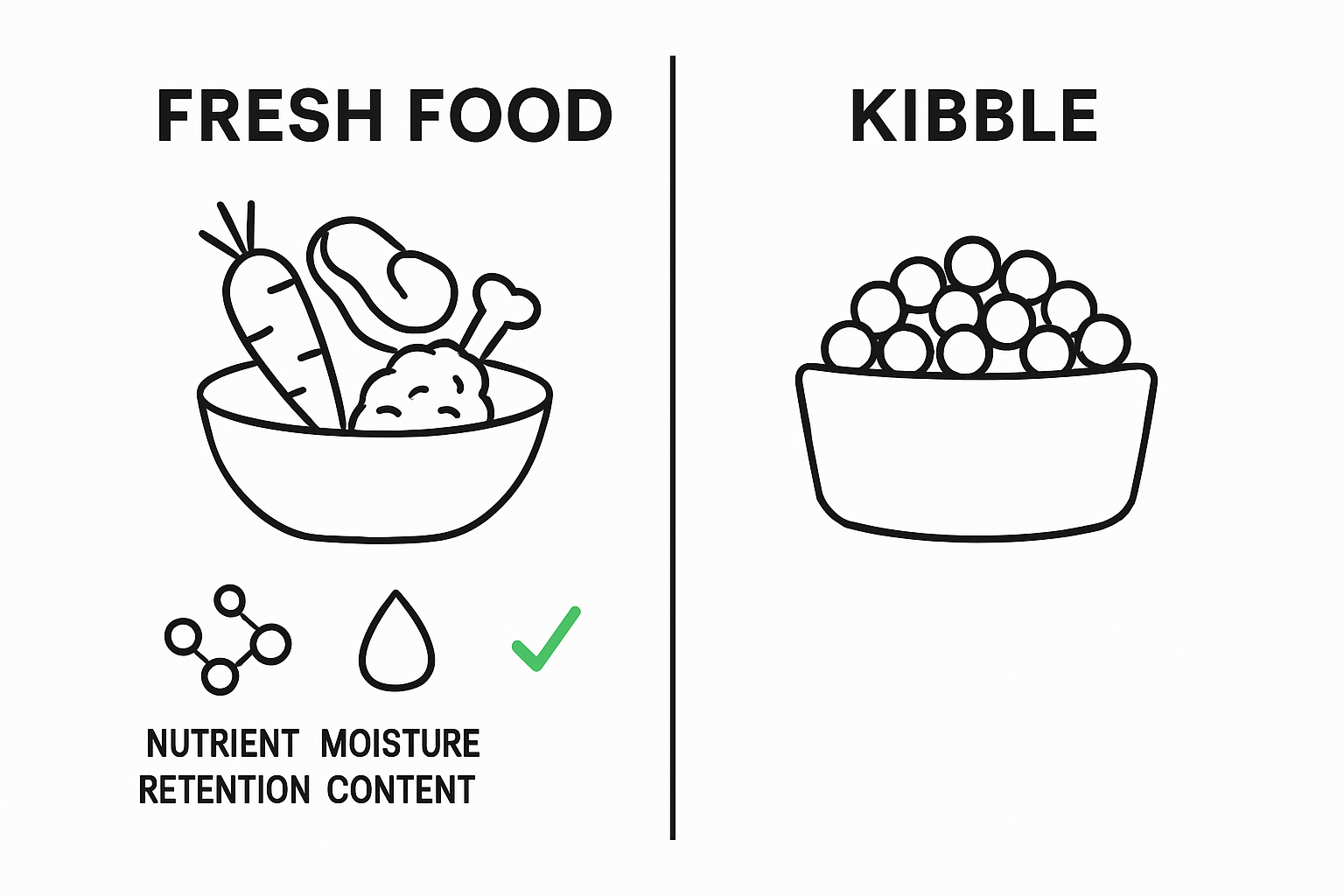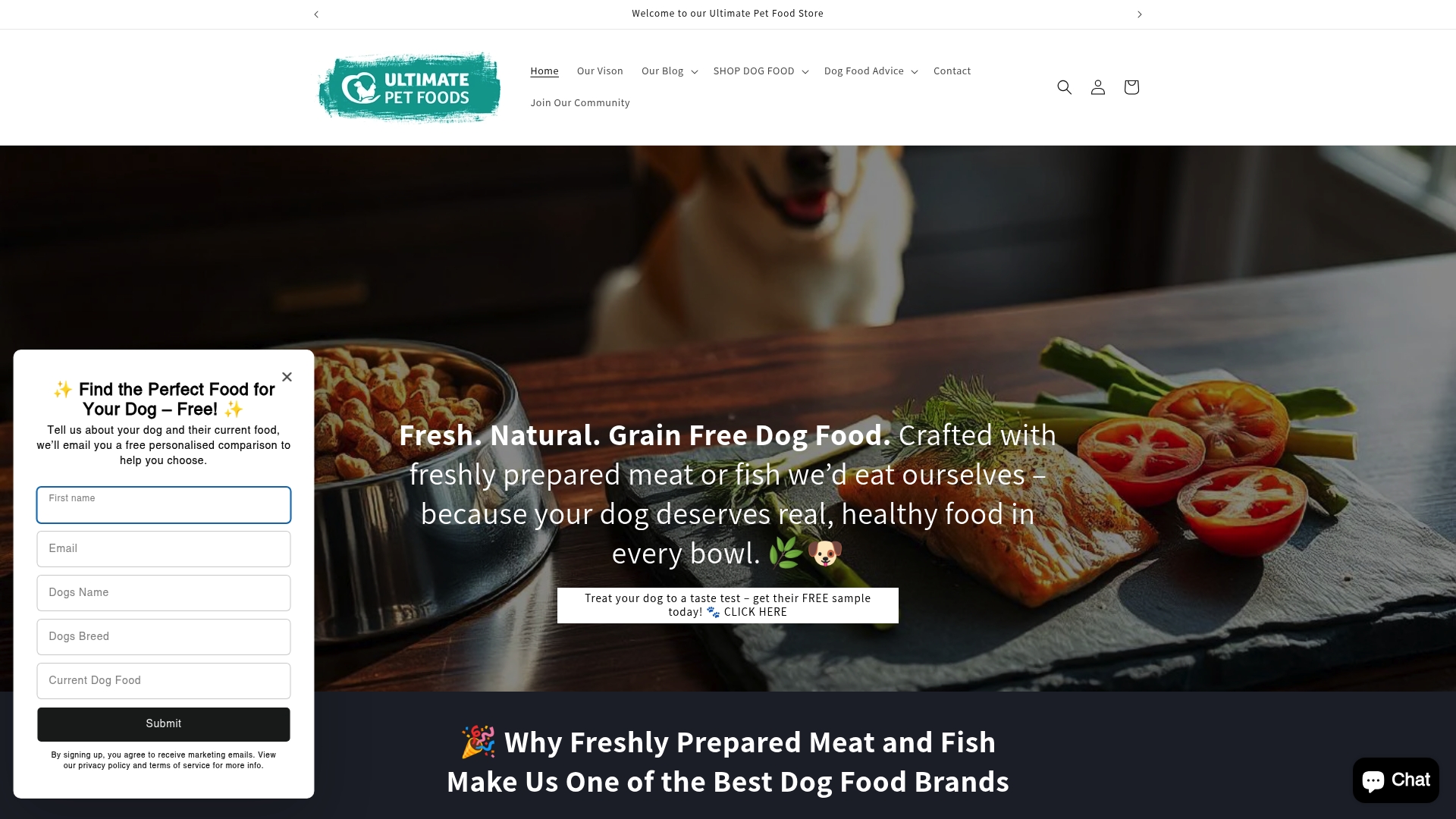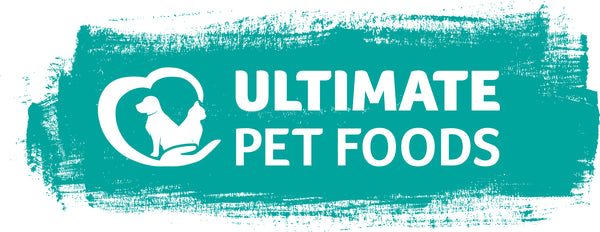
Understanding Fresh Dog Food vs Kibble: A Clear Comparison
Share
Dog food choices have come a long way, and now pet owners face a big decision between fresh dog food and classic kibble. Most people stick with kibble for its convenience, but did you know that fresh dog food often keeps more natural vitamins and minerals because it avoids high-temperature processing? That flips the usual thinking about what really matters in your dog’s bowl—sometimes the fresher route can mean a real difference in your pet’s health.
Table of Contents
- What Is Fresh Dog Food And Kibble?
- Why Nutrition Matters For Dogs
- How Ingredients Impact Dog Health
- Comparing Fresh Dog Food And Kibble Benefits
- Making Informed Choices For Your Dog’s Diet
Quick Summary
| Takeaway | Explanation |
|---|---|
| Fresh dog food offers superior nutrition. | Minimally processed ingredients retain essential nutrients that kibble may lack. |
| Consider your dog’s specific needs. | Nutrition varies by age, breed, weight, and health conditions; assess these factors. |
| Kibble provides convenience and standardization. | Long shelf life and easy storage make kibble a practical choice for busy owners. |
| Quality ingredients impact overall health. | High-quality, whole food ingredients support better energy and immune function. |
| Consult a vet for dietary choices. | Professional guidance ensures balanced nutrition tailored to your dog’s requirements. |
What is Fresh Dog Food and Kibble?
Dog nutrition has evolved dramatically, presenting pet owners with increasingly diverse feeding options. Fresh dog food and kibble represent two distinctly different approaches to canine nutrition, each with unique characteristics and potential benefits.
Understanding Fresh Dog Food
Fresh dog food is a modern nutritional approach that focuses on minimally processed, whole food ingredients prepared similarly to human meals. Unlike traditional processed options, fresh dog food is typically made with real, whole ingredients that are gently cooked or raw, maintaining more of their original nutritional profile. According to the Food Standards Agency, these foods can include a variety of unprocessed meat, offal, bones, and additional ingredients like fruits and vegetables.
Key characteristics of fresh dog food include:
- Higher moisture content
- More recognizable whole food ingredients
- Minimal processing
- Often prepared in smaller batches
- Typically refrigerated or frozen
Understanding Kibble
Kibble represents the traditional, mass-produced dog food format. These dry, pellet-like food products are manufactured through an extrusion process that combines ingredients under high heat and pressure. This process creates a shelf-stable product that can be stored at room temperature for extended periods. Learn more about kibble production in our comprehensive guide on dog food choices.
While kibble offers convenience and standardization, it often involves more processing, which can potentially reduce the nutritional value of its original ingredients. The extrusion process typically involves high temperatures that might degrade some nutrients, and manufacturers often add synthetic vitamins and minerals to compensate for nutritional losses during production.
Understanding these differences helps pet owners make informed decisions about their dog’s nutrition, considering factors like ingredient quality, processing methods, and individual health requirements.
Why Nutrition Matters for Dogs
Pet nutrition is far more than simply filling a food bowl. What dogs consume directly impacts their overall health, longevity, energy levels, and quality of life. Understanding the profound connection between diet and wellness helps owners make informed nutritional choices.
The Biological Impact of Nutrition
Nutrition plays a critical role in a dog’s physiological development and ongoing health maintenance. Different life stages require specific nutritional approaches, from puppy growth to senior dog care. Research from the University of Sheffield highlights how targeted nutrition can significantly influence a dog’s weight management and overall health.
Key nutritional requirements include:
- Balanced protein for muscle development
- Essential fatty acids for coat and skin health
- Complex carbohydrates for sustained energy
- Vitamins and minerals for immune function
- Adequate hydration
Long-Term Health Consequences
Poor nutrition can lead to serious health complications. Chronic dietary deficiencies or imbalances may contribute to numerous medical conditions, including obesity, diabetes, heart disease, and reduced immune function. Learn more about holistic dog nutrition approaches to comprehensively support your dog’s health.
By prioritizing high-quality, nutrient-dense foods tailored to individual needs, dog owners can proactively support their pet’s long-term wellness. This means considering factors like breed, age, activity level, and specific health conditions when selecting nutritional strategies.
How Ingredients Impact Dog Health
Ingredients are the foundation of canine nutrition, with each component playing a crucial role in supporting overall health, energy levels, and bodily functions. Understanding the impact of specific ingredients helps pet owners make informed dietary choices that promote their dog’s wellness.
Quality and Nutritional Value
The source and processing of ingredients significantly influence their nutritional benefits. Fresh, minimally processed ingredients typically retain more essential nutrients compared to heavily processed alternatives. Discover how to read dog food ingredients effectively to ensure you’re selecting the most nutritious options for your pet.
Key factors affecting ingredient quality include:
- Protein source and digestibility
- Nutrient bioavailability
- Presence of whole food ingredients
- Minimal chemical processing
- Absence of artificial preservatives
Potential Health Implications
Not all ingredients are created equal. Some can directly impact a dog’s health, while others might trigger allergies or contribute to long-term health issues. According to environmental nutrition research, home-cooked meals often provide superior nutritional benefits due to their ability to preserve vitamins and minerals that are typically destroyed in high-temperature processing.
Specific ingredients can address or exacerbate various health conditions. For instance, omega-3 fatty acids support joint health and reduce inflammation, while low-quality fillers might contribute to weight gain and digestive issues. Learn more about ingredients to avoid that could potentially harm your dog’s health.
By carefully selecting nutrient-dense, high-quality ingredients, pet owners can proactively support their dog’s immune system, maintain optimal weight, and potentially prevent diet-related health complications.

Comparing Fresh Dog Food and Kibble Benefits
Choosing between fresh dog food and kibble involves understanding their distinct advantages and potential drawbacks. Each feeding approach offers unique benefits that can significantly impact a dog’s overall health, nutrition, and quality of life.
Nutritional Composition and Quality
Fresh dog food typically provides superior nutritional value compared to traditional kibble. The minimal processing of fresh ingredients helps preserve essential nutrients, enzymes, and natural vitamins that are often diminished during high-temperature kibble manufacturing. Explore the insights on raw versus kibble dog food to understand these nuanced differences.
Key nutritional distinctions include:

- Higher protein bioavailability in fresh foods
- More natural vitamin and mineral retention
- Reduced reliance on synthetic nutrient supplements
- Better moisture content supporting hydration
- Enhanced digestibility of whole food ingredients
Practical Considerations
While fresh dog food offers remarkable nutritional advantages, kibble presents its own set of practical benefits. According to the Food Standards Agency, pet owners must carefully consider food safety when selecting less processed dietary options.
Kibble provides convenience and consistent nutritional standardization. Its long shelf life, ease of storage, and precise portion control make it an attractive option for busy pet owners. Additionally, kibble’s hard texture can help maintain dental health by reducing plaque buildup, a benefit not always present in softer fresh food alternatives.
Ultimately, the choice between fresh dog food and kibble depends on individual dog needs, owner preferences, lifestyle considerations, and specific health requirements.
Below is a comparison table outlining the key features, advantages, and considerations of fresh dog food versus kibble, helping readers quickly identify how each feeding approach differs.
| Feature/Benefit | Fresh Dog Food | Kibble |
|---|---|---|
| Processing Level | Minimally processed | Highly processed (extrusion, high heat) |
| Ingredient Quality | Whole, real foods, often human-grade | Variety of quality; may contain fillers/by-products |
| Nutrient Retention | High (more natural vitamins/minerals retained) | Lower (nutrients may degrade; synthetics added) |
| Moisture Content | High (supports hydration) | Low (dry, shelf-stable) |
| Storage/Convenience | Refrigerated/frozen, shorter shelf life | Room temperature, long shelf life |
| Portion Control | May require more measuring | Standardized, often pre-portioned |
| Digestibility | Enhanced (less processing, better absorption) | May be less digestible due to processing |
| Added Preservatives | Minimal or none | Common to ensure shelf life |
Making Informed Choices for Your Dog’s Diet
Selecting the right diet for your dog involves more than simply picking a popular brand or following trends. It requires careful consideration of individual nutritional needs, health status, lifestyle, and potential dietary sensitivities.
Assessing Individual Dog Needs
Every dog is unique, with nutritional requirements varying based on multiple factors. Age, breed, weight, activity level, and existing health conditions significantly influence dietary choices. Learn more about dog foods to avoid for optimal health to prevent potential nutritional missteps.
Key considerations when selecting a diet include:
This table summarizes the main considerations when assessing an individual dogs dietary needs, as discussed in the article, to support a tailored feeding approach.
| Consideration | Explanation |
|---|---|
| Health Status & Medical History | Assess current health and any existing medical conditions |
| Age & Life Stage | Nutritional needs vary for puppies, adults, and senior dogs |
| Breed Size & Metabolism | Different breeds and sizes require specific nutrient profiles |
| Activity Level | More active dogs need more calories and specific nutrients |
| Allergies & Sensitivities | Watch for adverse food reactions or known sensitivities |
| Lifestyle & Owner Preferences | Factor in feeding convenience, storage, and household routines |
- Current health status and medical history
- Age and life stage specific nutritional needs
- Breed size and metabolic requirements
- Activity level and energy expenditure
- Potential allergies or food sensitivities
Health and Safety Considerations
Dietary choices carry substantial health implications. According to research from the University of Bristol, certain feeding practices like raw meat diets can introduce significant health risks, including potential bacterial contamination.
Consulting with veterinary professionals is crucial for making informed dietary decisions. They can provide personalized guidance based on comprehensive health assessments, helping you navigate the complex landscape of dog nutrition. Professional recommendations can help mitigate risks associated with improper diet selection and ensure your dog receives balanced, appropriate nutrition.
Ultimately, the goal is to provide a diet that supports your dog’s overall health, energy levels, and longevity while addressing individual nutritional requirements and potential health challenges.
Discover the Healthier Path for Your Dog’s Nutrition
Are you struggling to decide between fresh dog food and traditional kibble for your dog? The article highlights important pain points such as understanding nutritional differences, ingredient quality, and the direct impact each feed type can have on your dog’s health, energy, and wellness. If you want a diet that truly supports better digestion, visible vitality, and long-term well-being, it is time to consider your options carefully.
Explore our grain-free small breed dog food which uses only natural, fresh ingredients to provide complete nutrition without unnecessary fillers. You will find carefully formulated diets tailored for sensitive dogs, puppies, and specific health needs at Ultimate Pet Foods. Each recipe aligns with what you have just learned—prioritizing whole food nutrition and ingredient transparency.

Give your dog a healthy start today. Visit Ultimate Pet Foods to browse premium choices backed by real science and years of expertise. Make feeding simple, nutritious, and worry-free with tailored formulas that suit your dog’s breed, age, and health challenges. Take your next step toward better nutrition now and see a noticeable difference in your dog’s happiness and vitality.
Frequently Asked Questions
What are the main differences between fresh dog food and kibble?
Fresh dog food is typically made from whole, minimally processed ingredients that are often cooked or raw, retaining more nutrients. Kibble is mass-produced, using high heat in an extrusion process, which can degrade nutritional value. Fresh food usually has higher moisture content and is stored refrigerated or frozen, while kibble is shelf-stable.
What are the health benefits of feeding my dog fresh food instead of kibble?
Fresh dog food can provide superior nutritional value due to higher bioavailability of proteins, vitamins, and minerals. It may enhance hydration levels, promote better digestion, and reduce reliance on synthetic supplements compared to kibble, which often undergoes more processing.
Can switching from kibble to fresh food affect my dog’s health?
Yes, switching to fresh food can positively affect your dog’s health by providing a more balanced and nutrient-dense diet. However, it’s important to transition slowly and consult your veterinarian to ensure the diet meets your dog’s specific nutritional needs, especially if they have any health issues.
How do I choose the right diet for my dog between fresh dog food and kibble?
Consider your dog’s unique factors such as age, breed, activity level, and any health concerns. Evaluate the nutritional profiles of both options and consult with a veterinary professional for personalized advice to select the best diet for your dog’s health and lifestyle.
